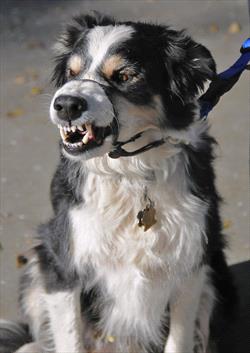Question:
Our 5-year-old Soft-Coated Wheaten Terrier presents as a furry, lovable and inviting dog while he sits waiting outside the cafe for me to finish my morning latte. Trouble is, he’s taken to growling and barking at some well-meaning types, especially those who come on too enthusiastically. It’s like they invade his space. This behavior is slowly starting to accelerate. What would be the best approach short of hanging a sign on him saying “Beware, looks can be deceiving”? — San Francisco
Answer:
You nailed the problem on the head. While Fido might be carefree and confident with you alongside, when he’s alone outdoors, life may look a bit more dangerous. All would be well if humans heeded the two golden rules: Never pet a dog without owner permission, and always let the dog make first contact. Unfortunately, naive well-wishers abound. These human space invaders approach too quickly, loom too largely or crowd too closely. To Fido, their friendly smiles and soft reassuring coos seem more like maniacal grins and suspiciously sweet overtones.
Under pressure, some dogs will freeze or shrink, pretending it’s all a bad dream. Others take action, usually with a reflex bark or low-level growl. A few successes with that method and the message is loud and clear: When strangers approach, growl and bark. Pretty soon, your sweet, slightly insecure dog has turned into a mass of defensive rumbling.
This isn’t the only dangerous scenario though. Whether your dog’s as amicable as a purple dinosaur or as fearful as an agoraphobic, tying outside is a touchy subject. Even the friendliest Fido can pack a surprise.
Take the case of Hershey, the ho-hum Labrador retriever. Screaming kids, overly exuberant strangers, rude off-lead dogs, he took them all in stride. Certainly no bite in his benign body. But then he met just the right kid: a 2 1/2-foot twerp imitating a giant squeaky toy. While Hershey was parked to a tree during his owner’s weekly errands, one rambunctious roughneck found a new source of fun. The post-toddler darted back and forth, in and out, like a pro training a protection dog to bite.
On the outside, it looked like good fun. His mother wasn’t concerned. A kid just bouncing and squealing like an injured rodent and a dopey brown dog wagging his tail dumbly and bowing up and down in play. No idea that the games were triggering that deep-seeded prey instinct that all dogs possess. Everything was fine and dandy until, with a joyful bark and a big puppy bounce, it was tooth against skin.
It was probably an accidental connection, a product of perfect timing, but it left one screaming child, one hysterical mom and a lot of blood. Hershey’s owner was outside in a snap and the bleeding stopped in another five. And while mom roared on about the vicious, unprovoked attack, Hershey sat patiently, a slow wag accompanying his puzzled face.
Outwardly, the consequences were small. For the boy, a small facial wound that healed seamlessly with stitches and for Hershey, a mandatory 10-day house arrest served by all biting dogs to rule out rabies. But the scars ran deeper. A little boy might now have a lifelong fear of dogs caused by a single improper greeting. A happy-go-lucky Hershey would have the brand of a bite in his history and no more errands to the store.
Does this one incident mean that all dogs should be banished from temporary tying? If so, Fido’s going to miss out on lots of great walks which means not only less exercise but also less practice in social situations. It’s all a calculated risk.
If your dog barks even happily at passers-by— human or canine —or darts forward to greet either class, a nix on the privileges is in order. However, if your dog is calm and confident enough to reliably endure a surprise hug from a stranger or an impromptu visit from a stray, maybe it’s OK. Or maybe not. In any case, the safest bet is to be close enough to monitor Fido and supervise all contact. (See Body Language of Fear poster)
What if you want your slightly scared dog to feel more at home around people in general and don’t plan to leave him tied up alone because you know already know the risks are too great? But you still want him to feel comfortable as you sit with him in an outdoor café?
The solution is simple but the execution an art. Teach Fido to associate good things with unfamiliar people. Set Fido out in a spot safe from strangers. Then have your friends walk past just out of range. If enough unfamiliar humans pass him as if he didn’t exist and simultaneously toss his favorite treats at his feet, Fido will eventually cherish the sight of strangers. But it’s also important to make sure that he lies down calmly and that they have good aim because you wouldn’t want him getting up and running over to jump on anyone who passes by. Your ultimate goal is that he remains relaxed, happy, calm and lying down so people will be able to safely pass as you enjoy your latte. Remember that no matter where you are you’ll need to keep your eyes open for potential poor greeters who might rush up and invade his space.
San Francisco Chronicle May 2000
Excerpted from Dr. Yin’s book, “How to Behave So Your Dog Behaves” Chapter 30 © 2004. TFH publishing



